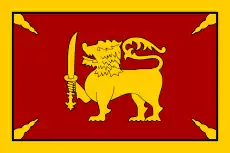Parakramabahu I
Parākramabāhu I (Pali Mahā Parākaramabāhu 1123–1186) was king of the Kingdom of Polonnaruwa from 1153-86. During his reign from the capital city of Polonnaruwa, he unified the three lesser kingdoms of the island, becoming one of the last monarchs in Sri Lankan history to do so. He oversaw the expansion and beautification of his capital, constructed extensive irrigation systems, reorganised the country's army, reformed Buddhist practices, encouraged the arts and undertook military campaigns in South India and Burma. The adage "not even a little water that comes from the rain must flow into the ocean without being made useful to man" is one of his most famous utterances.[1]
| Parākramabāhu I (Parākramabāhu the great) | |
|---|---|
| King of Sri Lanka | |
 The statue in Polonnaruwa traditionally held to be of Parākramabāhu the Great | |
| Reign | 1153–1186 |
| Predecessor | Gajabahu II |
| Successor | Vijayabâhu II |
| Born | 1123 Punkhagama |
| Died | 1186 (aged 62–63) Polonnaruwa |
| Consort | Queen Lilavati |
| House | Kingdom of Polonnaruwa |
| Father | King Manabharana |
| Mother | Queen Ratnavali |
Parākramabāhu spent much of his youth in the courts of his uncles Kitti Sri Megha, Prince of Dakkinadesa, and Sri Vallabha, Prince of Ruhuna respectively, as well as in the court of the King of Rajarata, Gajabahu II. He succeeded his uncle Kitti as king of Dakkhinadesa around 1140 and over the next decade improved both Dakkhinadesa's infrastructure and military. Following a protracted civil war, he secured power over the entire island around 1153 and remained in this position until his death in 1186. During Parākramabāhu's reign, he launched a punitive campaign against the kings of Burma, aided the Pandyan dynasty against the Chola dynasty in southern India and maintained extensive trade relations with China and countries in the Middle East.[2] Within the island, he consecrated religious monuments, built hospitals, social welfare units, canals and large reservoirs, such as the Sea of Parakrama.
Background
Early
The island of Sri Lanka was disrupted by South India, following Raja Raja Chola I's invasion of Sri Lanka in 993. These regions remained under Chola control until the reign of Vijayabahu I (1055–1100). Vijayabahu I successfully drove the Chola invaders out of the island and continued the capital at Polonnaruwa rather than Anuradhapura. By the reign of Vikramabāhu I (1111–1132), the island was divided into three kingdoms—Rajarata, Dakkhinadesa, and Ruhuna. Vijayabahu I gave his sister Mitta's hand in marriage to a Tamil Pandyan prince, and that Pandyan prince would go on to become the grandfather of Parakramabahu I.[note 1] Vikramabāhu was however regarded as the greatest in dignity as he possessed Rajarata with its sites of religious and historical importance. However, Manabharana, king of Dakkhinadesa ("South Country"), and his brothers Sri Vallabha and Kitti Sri Megha, the joint kings of Ruhuna, were formidable rivals for the crown.[4] Furthermore all three were the descendants of Vijayabahu's sister, and thus had a strong claim to the throne; they are referred to in the Culavamsa as the Arya branch of the royal dynasty, whilst Vikramabāhu I is of the Kalinga branch.
Birth

According to the ancient chronicle Culavamsa, Parākramabāhu's birth was predicted by a figure akin to a god seen in a dream by his father, King Manabharana of Dakkhinadesa (Capital as Panduwas Nuwara).[5] A son was duly born to Manabharana's wife Ratnavali, and was named Parākramabāhu because of his "foe-crushing arms".[6] Though the year of his birth cannot be known exactly confirmed, it is generally thought to be around 1123. The location would almost certainly have been the capital of Dakkhinadesa, Punkhagama.[7]
Upon being informed of the child's birth, Vikramabāhu I in Polonnaruwa ordered that the boy be brought up as the heir to his throne. This kind of adoption may have been an olive branch of sorts on the part of Vikramabāhu, who wished to keep the throne until his death, after which it would be passed on to Parākramabāhu. Manabharana, however, rejected the offer, stating that "It is not (prudent) ... to send away such a jewel of a son". He also speculated that "...if the boy is taken thither, the party of Vikkamabahu... will gleam with mighty, up-shooting flames, but our misfortune, alas so great, will become still worse!"[8] The schism that existed between the royal clans of Sri Lanka was too deep to allow for this manner of accommodation.
Soon after the child's birth, Manabharana fell ill and died. His younger brother Kitti Sri Megha, who was joint king of Ruhuna, ascended the throne of Dakkhinadesa, while Sri Vallabha was declared sole king of Ruhuna. Parākramabāhu, his mother Ratnavali and his two sisters Mitta and Pabhavati, were sent to live in Mahanagahula, the capital of Ruhuna, under the care of Sri Vallabha.[9]
Youth
In Ruhuna and Dakkhinadesa
The politics of Sri Lanka played a significant role in Parākramabāhu's upbringing. Whilst he was still young, his eldest sister Mitta was forcibly married to their cousin, Manabharana, the son of Sri Vallabha of Ruhuna, against the wishes of Queen Ratnavali.[10] Ratnavali was herself of the Kalinga clan of the royal family, and though she was the widow of a king of the Arya branch of the royal family, she preferred to see her daughters married to a king from the Kalinga clan. During his time at Sri Vallabha's court, Parākramabāhu met his future mahesi "queen consort", Lilavati, Sri Vallabha's daughter,[11] who, following Parākramabāhu's death, went on to rule the country in her own right.[12]
In 1132, following the death of Vikramabāhu, Gajabahu II succeeded to the throne of Rajarata. Taking advantage of the new king's youth, the two monarchs of the Arya branch of the royal family, Sri Vallabha and Kitti Sri Megha, tried unsuccessfully to seize Rajarata by force.[13] Gajabahu established himself firmly as ruler and therefore nominally senior to the two Arya kings[13] and neither Sri Vallabha nor Kitti Sri Megha would live to see the king of Rajarata dethroned.
After the end of the Arya-Kalinga civil war, Parākramabāhu left Sri Vallabha's palace in Ruhuna and returned to Sankhatthali, the new capital of Dakkhinadesa, where he took up residence with his uncle.[14] The Culavamsa attributes the departure to his impatience and lack of stimulation in Ruhuna.[15] It may also have been caused by Sri Vallabha's plans to place Manabharana of Ruhuna on the throne of Rajarata, which made Parākramabāhu's position increasingly precarious in court.[15] In Dakkhinadesa, on the other hand, he was well received by Kitti Sri Megha, who had no sons of his own, where he was essentially adopted; the Culavamsa thereafter refers to Kitti as Parākramabāhu's father. During his time at Dakkhinadesa, he studied important works of Chanakya and subjects such as grammar, literature, elephant-riding, martial arts, song and dance.[16]
In Rajarata
Some time after his coming of age, the young prince left Dakkhinadesa in secrecy and set out for Gajabahu II's realm in Rajarata. Having met his allies at Badalattha (modern Batalagoda), he visited the senapati Sankha, on the border between Rajarata and Dakkhinadesa. When Sankha tried to inform Kitti Sri Megha of the prince's journey, Parākramabāhu had him killed.[17] Sankha had been his guardian and Kitti Sri Megha described him as 'mightiest vassal in my kingdom', making the murder all the more serious.[18] Parākramabāhu then seized Buddhagama (modern Menikdena Nuwara) and all of Sankha's property.[7] He continued his journey, having evaded a force sent against him by Kitti Sri Megha, who feared complications with the court of Polonnaruwa, and traveled through the Malaya region to Gajabahu's court.[7]
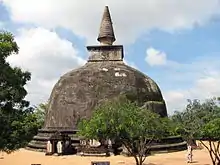
The reasons for Parākramabāhu behavior are considered uncertain, but according to the Culavamsa, his journey was essentially one of reconnaissance.[19] Although the three monarchs of the provinces were united, they all harbored the wish the govern the kingdom of Rajarata. At the time, however, it was suggested that none of them could take control of Rajarata, due to the limited resources available in their small provinces.[19] Parakramabahu did not wish to believe this, and thus traveled to Rajarata to learn the conditions of the province himself.[19]
The reason provided for Kitti Sri Megha's efforts to bring the prince back to Dakkhinadesa are presented as nothing more than concern for the well being of his nephew as well as concerns that Parākramabāhu may reignite hostilities between the Arya and Kalinga factions. However, that the king of Dakkhinadesa was "tenderly attached" to his nephew is regarded as "fiction", and it is pointed out that "the spirit in which the accounts of these conflicts are conceived is irreconcilable with the theory of untroubled relations between uncle and nephew."[20]
During his time in Gajabahu’s court, the Parākramabāhu did two things of significance. The first was to enmesh the court of Gajabahu in a web of espionage and the other was to marry one of his sisters called Bhaddavati, to King Gajabahu. Through this marriage, Parākramabāhu managed matters that Gajabahu II completely trusted him, as much as he did the royal family.[21] Nevertheless, he retained the entirety of Bhaddavati’s dowry for himself, and entered into secret negotiations with Gajabahu’s general, Gokanna. Gajabahu eventually grew suspicious of Parākramabāhu’s activities, and Parākramabāhu departed Rajarata in secrecy by night and returned to Dakkhinadesa.[22]
Return to Dakkhinadesa
In Dakkhinadesa, Parākramabāhu was reluctant to enter the capital Sankhatthali to see his uncle, King Kitti Sri Megha, until persuaded by his mother Ratnavali to do so. Kitti Sri Megha however died soon after Parākramabāhu's return and the Culavamsa notes that the prince "was not mastered by the agitation called forth by the grief at his father's (sic) death"—perhaps a sign of lingering ill feeling between the two.[23] Parākramabāhu was now king of Dakkhinadesa.
King of Dakkhinadesa
Government
Parākramabāhu's objective for Dakkhinadesa was to expand it so that it would surpass the greatness of other kingdoms, in a short period of time.[24] He started a huge program of construction and renovation, the remnants of which can still be seen in North Central Province, Sri Lanka, today. It is mentioned of him as having restored an ancient causeway called the Kotabaddha, over the Deduru Oya (Deduru Lake) near modern Kurunegala.[25] The new king's personality was illustrated when the architects commissioned to the project informed him that it was well-nigh impossible to carry out, to which Parākramabāhu replied that "What is there in the world that cannot be carried out by people of energy?".[26] He ordered the construction of canals and dams, and cleared a large area of forest around them for new fields. Most notably, he constructed the Parakrama Samudra, a giant reservoir from which a large swathe of territory derived its water supply. On islands in the middle of the reservoir he constructed a palace and a stupa.[27]
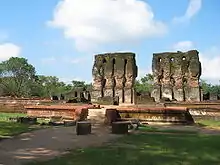
He transformed the royal court, making it a hub of cultural activity, attracting young nobles skilled in various arts such as riding elephants or horses, swordsmanship, in the use of foreign tongues and in dance and song. He reformed the government of Dakkhinadesa, creating two ministries; the military affairs and the internal administration to which he later added a third department, which oversaw the management of mines. Trade was an important component of Dakkhinadesa's income since the island of Sri Lanka, given its geographical position, had always been at the junction of several major trade routes. Chinese silk was a significant import and was used in the consecration of statues and shrines.[28] Pearls and gems (of which the king took particular interest) constituted an important part of the island's exports, as did cinnamon (which remained, until the 19th century, Sri Lanka's major export), and war elephants.[29] Most trade was carried out through the main seaports of the principality, Kalpitiya, Halaavatha (Chilaw) and Colombo.[30]
Preparation for war
Parākramabāhu's army had a diverse ethnic make-up. Some of his officers were from the two grand old clans of Sri Lanka, the Moriya and the Lambakanna, who had between them dominated Rajarata from Anuradhapura. Under a man styling himself the king of Malaya (modern Dumbara). By the time hostilities broke out between Dakkhinadesa and Rajarata, the former's forces also included Veddas,[31] Vellalar, and people from the lower castes not traditionally involved in martial activities. The Culavamsa places the number of soldiers at somewhere around 100,000 people but the real figure was probably lower.[32] Parākramabāhu would have been able to field war elephants, cavalry, and siege engines, and his force represented a serious threat to Gajabahu's power in the north.
War with Gajabahu
Around 1150, Parākramabāhu made his first move by seizing control of Malaya, strategically securing his eastern flank. He then moved his forces against various chieftains on the border of Rajarata. The final stage of this early campaign was the defeat of an army of Gajabahu himself, after which there was a brief ceasefire between the two sides.[33]
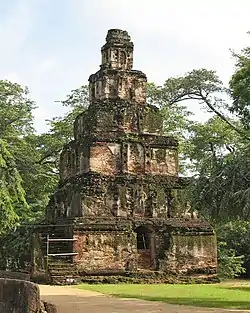
Hostilities resumed soon afterwards. Gajabahu had resorted to securing support from abroad, and by the time hostilities resumed between him and Parākramabāhu, the army of Rajarata included nobles of heretical faith from abroad.[34] Parākramabāhu himself did not participate in the invasion of Rajarata, but was responsible for the overall strategy of the campaign, which was based on the writings of Kautilya.[35]
The forces of Dakkhinadesa struck at the fortress of Mallavalana near the mouth of the Kala Oya, seizing it and occupying the western coast of Sri Lanka. The army then sailed up to the north and landed at a place called Muttakara or Mutukara ('Pearl-mine') near modern Mannar, Sri Lanka.[36] In the meantime, Gajabahu's senior general Gokanna suffered several defeats in the vicinity of Kala Vewa and was forced to appeal to the king of Rajarata for reinforcements.[37] Despite receiving these and meeting with some success in Malaya, Gokanna was again defeated by Parākramabāhu's general Mahinda, a rout so total that Gokanna fled the battle scene leaving behind his umbrella, an important status symbol in medieval Sri Lanka. The remnants of his force constructed a fortress in a jungle and took no further part in the war.[38]
By 1153, Parākramabāhu's forces were in a position to take Polonnaruwa. Rakkha and a junior general named Sukha inflicted another defeat on Gajabahu just 15 kilometres (9 mi) from the city, seizing the capital of Rajarata soon afterwards.[39] The king and his two sons, Colaganga and Vikramabāhu, were imprisoned. Parākramabāhu was magnanimous in defeat, and laid out clear orders for the treatment of both the former king and the townspeople to his generals:
If the heads of districts and the officers, grown insolent by their victory in fight, slay the King (Gajabahu) whom they have captured, that is not right. And if they plunder the town and ill-treat the people and become unbridled, that is likewise not right. The gaining of the royal dignity takes place for the welfare of the order (Sangha) and the people alone, but not for the purpose of slaying... Therefore thou must go there, hold the unbridled in check, take the King under thy protection and make the town secure.[40]
However some members of Parākramabāhu's army are known to have disregarded his commands and broken open house doors in Polonnaruwa, plundered goods and stole raiment and ornaments from the people of the city.[40][41]
The pillaging of Polonnaruwa was to have dire consequences for Parākramabāhu. Angered by the actions of the forces from Dakkhinadesa, the nobles and allies of Gajabahu—including his general Gokanna—appealed to Manabharana of Ruhuna, who was at Sorabara, in the center of the country, for assistance. Despite having an alliance with Gajabahu, Manabharana had remained neutral in the war up till that point. Then, on the eve of Parākramabāhu's victory, he stepped into the conflict and launched an invasion of Rajarata.
War with Manabharana and Gajabahu
Parākramabāhu sent his senapathi Deva to restore order to Polonnaruwa, but he found himself in battle with Manabharana before he could reorganize his troops. The king of Ruhuna kept to his word and delivered Parākramabāhu's forces a crushing blow, driving them from Polonnaruwa. For the Kalinga clan however, the alliance with Manabharana backfired as it was soon made clear that Manabharana intended to keep the city for himself. He put to death many of Gajabahu's senior officials, and imprisoned Gajabahu in a dungeon. Manabharana's mother, Sugala (the niece of Vijayabahu I), and his wives were soon summoned from the south to live in Rajarata. The sacred relic of the tooth of the Buddha and the Alms Bowl Relic, long kept in the south, were now returned under his aegis to the north.[43]
Gajabahu then appealed to Parākramabāhu for assistance, and Parākramabāhu ordered his troops to cut off grain supplies to Polonnaruwa and harass travelers on the roads between Ruhuna and Rajarata. As a result, all the people in the town with King Manabharana became "weakened birds in a cage".[44] With the sporadic attacks from Dakkhinadesan forces slowly grinding down his power in the north, Manabharana left Polonnaruwa to attack a force commanded by Rakkha that had been wreaking havoc in western Rajarata. In his absence Parākramabāhu's forces seized Polonnaruwa, liberated Gajabahu II, and took into their possession the entirety of Manabharana's treasury. The disheartened king of Ruhuna returned to the south with his family and the sacred relics.
Gajabahu, who had been set free, left Polonnaruwa before Parākramabāhu arrived and decided to leave the country by ship. However, an attack by some of Gajabahu's followers on Parākramabāhu's troops reignited hostilities between the two, and Parākramabāhu sent his army to capture Gajabahu. By late 1153, after suffering a number of defeats, Gajabahu realized his capture was imminent, and appealed to the Sangha to intervene. They persuaded Parākramabāhu that the ailing king no longer posed a threat, and that he should be allowed to live out the rest of his days in peace. Manabharana tried to woo the king back to the battle against Parākramabāhu, but Gajabahu refused, having the words "I have made over Rajarata to Parākramabāhu" inscribed on a stone tablet (named Sangamuwa Inscription[46])to confirm his abdication in favor of Parākramabāhu.[47] Gajabahu moved to Gantale (Kantalai[48]), where he died in the 22nd year after his coronation as king of Rajarata.[7]
Coronation and defeat of Manabharana
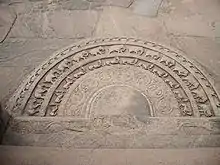
Parākramabāhu was immediately crowned king of Rajarata, but the war was far from over. Manabharana struck again, sending his armies to the Mahaweli River and attempting to cross into Rajarata via two fords. In the meantime, Narayana, a chieftain based at Anuradhapura, rose in rebellion, and Parākramabāhu's hold in the north was again threatened.
On this occasion Parākramabāhu decided to vanquish Manabharana once and for all; "Not even in Rohana will I permit King Manabharana who is here crushed in war, to find a hold".[49] Rakkha was commanded to hold the fords at the Mahaweli while Parākramabāhu himself attacked from Dakkhinadesa into Ruhuna. Narayan's rebellion was suppressed by another force, leaving Rakkha, who had successfully held the fords at the Mahaweli River, free to invade from the north.
If Parākramabāhu had hoped for a swift victory, it did not happen. Manabharana defeated Rakkha's army and drove them back to Rajarata. Parākramabāhu found himself facing dissension within his own ranks and the defeat of his forces in Malaya; Manabharana even recaptured Polonnaruwa and with it most of Rajarata.[50] Despite this Parākramabāhu persevered with the offensive, withdrawing from his southern campaign and concentrating his forces in the north. Manabharana once again found himself besieged in Polonnaruwa. Both sides were exhausted by the incessant warfare of the preceding years, and Manabharana eventually fled the city for Ruhuna. His forces were overtaken at the Mahaweli River by Parākramabāhu's army and annihilated; the king returned to the south in time to pass away from a combination of disease and exhaustion.[51]
Parākramabāhu was finally the unquestioned lord of the entire island of Sri Lanka, even though it had been at the cost of around five years of incessant warfare. In years to come the king himself was to regard this war as one of the most significant events of his reign, mentioning it in several of his edicts carved on stone, such as the one near Devangala.[52] He celebrated by summoning Manabharana's son to Polonnaruwa and concluding a peace with him, followed by a lavish coronation ceremony.[53]
| Timeline of accession of Parākramabāhu to the throne | ||||||||||||||||||||||||||||||||||||||||||||||||
| Kingdom | Monarch | |||||||||||||||||||||||||||||||||||||||||||||||
| 1090 | 1100 | 1110 | 1120 | 1130 | 1140 | 1150 | 1160 | 1170 | 1180 | |||||||||||||||||||||||||||||||||||||||
| Rajarata | Vikramabāhu I | Gajabāhu II | ||||||||||||||||||||||||||||||||||||||||||||||
| Dakkhinadesa | Vijayabāhu I | Manabharana | Kitti Sri Megha | Parākramabāhu I | ||||||||||||||||||||||||||||||||||||||||||||
| Ruhuna | Sri Vallabha & Kitti Sri Megha | Sri Vallabha | Manabharana | |||||||||||||||||||||||||||||||||||||||||||||
Reign
Parākramabāhu established himself at Polonnaruwa (Pulatthinagara as mentioned in the Chulavamsa) from 1153 onwards and ruled over the entirety of Sri Lanka for the next 33 years. During this time he undertook much of the work he is best remembered for, most significantly in the areas of religious reform, construction, and war.
Religious reform

During the reign of king Vatta Gamini Abhaya (Valagamba, 104 BCE, 88–76 BCE), the sangha of the country had divided into three rival orders—the Theravada orders of the Mahavihara, Abhayagiri vihāra and Dakkhina vihara.[54] One of Parākramabāhu's ambitions was the reunification of these groups into one order, as had existed at the time of Dutugamunu. Furthermore, much of the sangha had become corrupted over the years, with bhikkhus marrying and having children, and in many cases behaving much like upāsakas in their pursuit of worldly gain.[55]
Around 1165, a council was called in Polonnaruwa to discuss the reform of the sangha.[7] Parākramabāhu's chief agent in the enterprise was to be the Mahathera Kassapa, an experienced monk who "knew the Tipiṭaka and was exceedingly well versed in the Vinaya".[56] There was immense resistance to Parākramabāhu's efforts, in particular from the Abhayagiri sect who now adhered to the Vetullavada tradition, who the king found to be particularly corrupt. Many monks moved abroad rather than participate in the reforms, whilst others simply abandoned the cloth and returned to lay life. In this they may well have been encouraged by Parākramabāhu, who seems to have felt that the "purification" of the priestly orders depended as much on the expulsion and exclusion of the corrupt as it did on the rewarding and encouragement of the orthodox. There are several references to individuals being given "lucrative positions" in order to keep them out of their respective Orders.[58] Finally, the king summoned the leaders of the sangha on the island once a year, centering the visit on a ritual on the banks of the Mahaweli river—possibly a practical means of keeping up-to-date with their progress and their standards.[58]
Following the crushing of Queen Sugala's rebellion in 1157, Parākramabāhu had the Tooth Relic and the Alms Bowl Relic brought to Polonnaruwa; the former was placed inside a jewel in the Temple of the Tooth Relic in Polonnaruwa.[59] Such constructions became a hallmark of Parākramabāhu's reign; his buildings for the sangha are described in great detail in the Culavamsa and comprise an impressive body of work, often accompanied with inscriptions stating his intentions and accomplishments, such as at the Gal Vihara.[60]
Construction
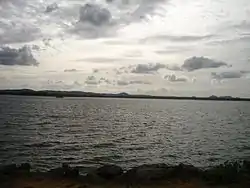
Parākramabāhu's constructions work made up a significant chunk of the material history of Sri Lanka. Much of the remnants of Polonnaruwa date from his reign, as well as sites in western and south-eastern Sri Lanka. One of Parākramabāhu's first projects was the restoration of Anuradhapura, the ancient capital of Sri Lankan Kings which had been utterly destroyed by the Chola army, including the restoration of Thuparamaya (which had been lost to the jungle), Mihintale, and Ruwanwelisaya.[62][63] Then, having founded an administrative center called Parakramapura, he turned his attention on Polonnaruwa. Unsurprisingly, due to the near-yearly sieges, the city had suffered and had reached a state that nothing but its name remained. It is perhaps because of this that so little of pre-12th century Polonnaruwa remains until today.[28]
The king initially divided the city into four districts or suburbs, each marked with its own alms-giving house for the clergy, containing "vessels of bronze, cushions and pillows, mats, carpets and bedsteads".[64] He ordered the construction of hospitals, which he visited on several occasions.[65] He also expanded Polonnaruwa's defensive walls, constructing an elaborate three-walled complex featuring turrets for archers and fourteen gates. None of which has survived till modern times. Beyond the city precinct it is believed he constructed or renovated three smaller townships, in addition to Parakramapura - Rajavesi Bhujanga, Raja Kulantaka (Sinhapura), and Vijitapura.[66] Extensive gardens were also laid down around Polonnaruwa, featuring ponds and bathing-pools, one of which, the Twin Pools, survives till this date. One such garden, the 'Island Garden', extended into the middle of Thupa Vewa ('Vewa' meaning 'tank' or 'reservoir' in Sinhala) on a promontory.[67]
Much else survives, such as the Gal Vihare, or "Stone Shrine", near Polonnaruwa. The Culavamsa attributes the monument in its entirety to Parākramabāhu, though in truth his contribution may have been extensive refurbishment.[68] The Vatadage, or "Circular Temple", was constructed around 1157 following the suppression of Queen Sugala's revolt in Ruhuna, to host the recently recovered Tooth Relic and Alms Bowl Relic. The Lankatilaka Temple, Alahena Pirivena, Jetavanaramaya and the Demala Maha Cetiya were also constructed in his reign. At the center of Polonnaruwa Parākramabāhu expanded and beatified the royal palace. Little of it remains today, but its soaring walls hint at the grand scale of the king's vision.
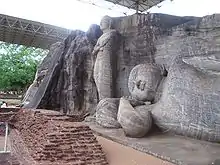
Parākramabāhu also continued his program of hydraulic works begun in Dakkhinadesa, including the renovation and reconstruction of reservoirs and canals wrecked during the Chola invasion. Inscriptions detailing his work can be found at the Maha Vewa near Uruwela, Padaviya Vewa and Panda Vewa in North-Western Province. A column discovered at the bottom of the Padaviya Vewa in the 19th century included the inscription "Made for the benefit of the whole world by the prosperous Sri Parakrama-Bahu, born at Sinhapura, minded of what was fit to be done".[69] Though the Culavamsa attributes the construction of various tanks to him, it has been suggested that much of Parākramabāhu's work was renovation, and indeed that some of the projects undertaken by his successor, Nissanka Malla of Polonnaruwa, may have been attributed to him.[70] In all Parākramabāhu is said to have restored or constructed over 216 reservoirs and tanks.
Despite their magnificence, Parākramabāhu's works exacted a heavy toll on the populace and the treasury. For much of the work in Anuradhapura he utilized Tamil prisoners of war seized during the Pandyan War.[71] Nevertheless taxation and rajakariya (a feudal system in which work was owed to the king by commoners) contributed in large part to the projects. An interesting indicator of the burden of taxation is the disappearance of larger gold coins towards the end of Parākramabāhu's reign.[7]
Military campaigns
Parākramabāhu's reign is memorable for two major campaigns—in the south of India as part of a Pandyan war of succession, and a punitive strike against the kings of Ramañña (Lower Burma) for various perceived insults to Sri Lanka. He also had to suppress wars against him in Ruhuna on several occasions.
Revolts
In 1156, Queen Sugala of Ruhuna, the mother of Manabharana of Ruhuna who had fought Parākramabāhu bitterly for the throne, joined a revolt against Parākramabāhu. The situation turned dire when a group of mercenaries took the opportunity afforded by the absence of Parākramabāhu's army, and his most formidable general Rakkha, to revolt in 1157.
Whilst the insurrection continued in the north, Parākramabāhu dispatched another general, Bhuta, to assist Rakkha, who had become bogged down in conflict in Ruhuna. The Culavamsa mentions the soldiers in Bhuta's army wearing "doublets made of buffalo hide"[72] to protect themselves against arrows. Despite reinforcements Rakkha and Bhuta appear to have become stuck in a war of attrition not unlike Parākramabāhu's wars for the throne. Certainly it outlasted a simultaneous rebellion in the north, which after three months of fighting ended after an engagement in the vicinity of Dik Vewa. The only major victory of this early phase of the rebellion in Ruhuna was the seizure of the Sacred Relics in late 1157.
The tide finally turned when reinforcements arrived in Ruhuna, probably in early 1158, through Sabaragamuwa, and from the western coast.[7] Mahagama was seized and Queen Sugala captured. The forces of Parākramabāhu then inflicted something of a bloodbath on the nobility and citizens of Ruhuna, seemingly with the king's approval. "They caused many foes to whom severity was due, to be brought before them, and at villages and market-towns they had numbers of stakes set up on which they impaled many hundreds of the enemy. Many other foes they had hanged on the gallows and burnt and showed forth in every way the majesty of Parākramabāhu".[73] It may well have been the case that the king was tired of the constant animosity directed at him by the kingdom. The brutal suppression of the rebellion ensured that, apart from a brief insurrection in 1160, Ruhuna remained quiet for the rest of his reign. The fate of Queen Sugala is not recorded. The only other rebellion of Parākramabāhu's reign occurred in the region of modern Mantota in from 1168–1169.
War with Bagan, 1167–1171
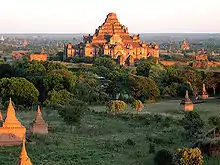
The city-state of Bagan (modern Burma), and Sri Lanka had enjoyed a cordial relationship based on trade and a common faith (Theravada Buddhism) for a long time. Bagan emerged as a power in the 9th century and by the 11th century its capital city, Arimaddhanapura, was a centre of Buddhist learning.
However with the accession of Narathu (1167–1171), the grandson of Alaung Sithu, to the throne, the situation changed dramatically. Initially he deprived the envoys of the King of Sri Lanka the maintenance they were previously granted.[74] He also issued an order prohibiting the sale of elephants to foreign countries and did away with the age old custom of presenting an elephant to every foreign vessel which brought him gifts. He later had the Sri Lankan envoys imprisoned and tortured, and had all their possessions, including their money, their elephants and their vessels confiscated. He later summoned them and declared,
Henceforth no vessel from the Sinhala country shall be sent to my kingdom. Give us now in writing the declaration that if [messengers] from there are again sent to us, in case we should slay the envoys who have come here, no blame of any kind will attach to us. If ye give not the declaration ye shall not have permission to return home.[74]
It is not certain whether this was part of a particular moved against Sri Lankan merchants, or a general closing down of Baganese borders. Whatever the reason, Parākramabāhu was incensed. Assembling a fleet at Pallavavanka, he dispatched to Bagan a formidable force. The size of the army is not known, but it is recorded as containing a year's supply of grains, specially modified arrows, and Sri Lanka's fearsome war elephants. Despite setbacks en route, including the sinking of one ship and the loss of a few others, the army arrived at the city of Kusumiya (modern Pathein) on the banks of the Bago river, and captured it.[7][75] Thereafter, the armies captured several other cities, including Arimaddhanapura, killed Narathu, and restored relations between the two countries to normal.
The account of the campaign in Bagan is possibly exaggerated, particularly as Burmese chronicles do not contain any information on a massive invasion from Lanka. Nevertheless there is evidence to indicate that there was some form of campaign undertaken, and that it was a successful one. The story of a Sri Lankan invasion that dethroned Narathu is known in Myanmar.[76] Furthermore, contemporary inscriptions from Devanagala mentions the awarding of land to the general Kitti Nagaragiri for his leadership in a campaign to 'Ramanna', naming the king of Bagan as 'Bhuvanaditta', a possible Lankanization of 'Narathu'.[77]
George Coedes states Parakramabahu I launched a retaliatory raid against Paga in 1180, after Narapatisithu imprisoned Singhalese envoys, tradesmen, and a princess on her way to Cambodia.[78]:177
Pandya War, 1167–1183


In 1167 the Pandyan king Parakrama appealed to his namesake in Lanka for assistance against an alliance of his rival Kulasekhara Pandya and the Cholas. Such an appeal was not unusual, as the Pandya had long found allies in the Sinhalese against the Cholas, and their nobility had spent some time in exile at the court of Mahinda IV (956–972) after the invasion of their land by Parantaka Chola II.
On this occasion however the Sri Lankan help came too late. By the time Parākramabāhu's general Lankapura Dandanatha arrived in Pandya Nadu, Kulasekhara had captured the capital city of Madurai and killed Parakrama's wife and children. His son Prince Virapandu however had managed to escape. Rather than head for Madurai, Lankapura landed in the vicinity of Ramanathapuram and captured the city of Rameswaram, which remained in Sri Lankan hands for the next thirty years or so.[7] Here they built a fortress called Parakramapura. In this early phase of the war they fought Kulasekhara on several occasions, eventually laying siege to him in Madurai and seizing the city. Virapandu was restored to power, but apparently only as a puppet, as the they under Lankapura remained in Madurai and continued to engage the Chola across south India.[79]
The Culavamsa dedicates much of chapter LXXVII to a description of the ensuing war between Lankapura and Kulasekhara, who apparently fought on with assistance from the Cheras. The Lankan effort was so successful that Parākramabāhu appears to have established a near-permanent authority over Pandya Nadu (the chapter is entitled Conquest of the Pandya Kingdom), even establishing a city called Panduvijaya in commemoration of the conquest.[80] However the account ends abruptly. No mention is made of Lankapura's return to Sri Lanka, nor of whether Virapandu III succeeded on hanging on to power.
The remainder of the story can be gleaned from inscriptions in south India and by inference. The Sinhala army is known to have scored a number of victories over the Chola army. Lankapura is said to have returned to Sri Lanka as a war hero and rewarded for his valor in battle. Nevertheless the forces of Parākramabāhu appear to have remained in Pandya Nadu, scoring victories over Rajadhiraja II in 1176. It was not until 1181 when Virapandya III was defeated that the they withdrew from Pandya Nadu, retaining only the area around Rameswaram.
Death and legacy
The Culavamsa states only that Parākramabāhu "carried on rule for thirty-three years", and that he died in Polonnaruwa. He was succeeded by Vijayabahu II of Polonnaruwa, described as his "sister's son", who he had summoned from Sinhapura, capital of Kalinga.[81] It is highly unlikely that Vijayabahu was son of either Pabhavati or Mitta, Parākramabāhu's sisters who were married to Manabharana of Ruhuna, as this would not explain why he had to be summoned from Kalinga. Nor could he be son of Gajabahu and Bhaddavati, the other named sister of the king, as the Culavamsa explicitly states that Gajabahu had no sons who outlived him.[82] It has been postulated that Vijayabahu was in fact the son of an unknown fourth sister who had been married to a king of Kalinga. His place of burial is unknown.
During his reign, Sri Lankan power contributed to the destabilizing of the Chola dynasty of south India and Sri Lankan forces continued to have a presence in Rameswaram till the end of the 12th century. There are also records of Sinhala victories until well into the reign of King Nissanka Malla (1187–1196).[7] Furthermore the sheer size and extent of the king's construction projects can still be seen in Polonnaruwa today, as well as in the various carvings dotted around the country vaunting the accomplishments of the "Great King". However such success came at a price. Relentless warfare took its toll on the country and taxation was high under his reign and high-value coinage all but disappeared towards the end of his rule, a sign of increasing poverty. One of his successor Nissanka Malla's most popular actions was reducing taxation.[7]
Despite his personal reputation and authority, Parākramabāhu did not take any steps towards ensuring a smooth succession. One reason offered is the strength of Sri Lankan conventional law, which contained fairly fluid conventions for the replacement of rulers.[83] The chronic instability of the years after his reign undid many of his accomplishments and developed into a crisis that the country never recovered from. The popularity of Parākramabāhu is attested by the fact that no less than seven monarchs adopted his name over the next four centuries, of whom only two or three could lay claim to even a fraction of his successes. His ultimate weakness was the lack of restraint in his spending, taking Sri Lanka to greater heights that it had reached in a long time, but exhausting the island's resources in the process.[84]
The Sri Lankan Navy has two ships named after Parakramabahu.
See also
- Mahavamsa
- List of monarchs of Sri Lanka
- History of Sri Lanka
- Architecture of ancient Sri Lanka
Notes
Much information used in this article was gleaned from Willian Geiger's extensive footnotes to his translation of the Culavamsa.
- Culavamsa, LXVIII, 8
- Kenneth Hall, "Economic History of Early South Asia", in Nicholas Tarling (ed), The Cambridge History of South East Asia, Vol. I, Cambridge 1994
- Indrapala, K. (2005). The Evolution of an Ethnic Identity - The Tamils of Sri Lanka 300 B.C.E to 1200 C.E. ISBN 0-646-42546-3. p. 250
- Culavamsa, Chapter LXI
- Manabharana saw in a dream a wondrous god with glittering raiment and ornaments, adorned with fragrant flower wreaths, illuminating with his sublime beauty and the glory of his presence the whole heavens...and he heard him speak thus: "Be content, O greatly blessed! Be joyful, O King! A splendid son, furnished with the tokens of power...of a courage whose splendor shall spread through the world, glorious in might and strength, honor and fame, a fount of excellent qualities, a furtherer of the Order and of the laity shall be attained by thee ere long, O mighty King!"; Culavamsa, LXII 12–29
- Culavamsa, Chapter LXII, 52–53
- Codrington, A Short History, chap. IV
- Culavamsa, Chapter LXII, 62–67
- Culavamsa, Chapter LXII, 68
- Culavamsa, Chapter LXIII, 15
- "Pali Names". Retrieved 2006-10-30.
- Lilavati would rule Sri Lanka on three separate occasions, from 1197–1200, from 1209–1210 and from 1211-1212 - Paranavitana, History of Ceylon, p. 345
- Culavamsa, Chapter LXIII, 23
- Culavamsa, Chapter LXIV, 7
- Culavamsa, Chapter LXIII, 41
- Culavamsa, Chapter LXIV, 5–9
- Culavamsa, Chapter LXIV, 36–38
- Culavamsa, Chapter LXVI, 60
- Culavamsa, LXIV 55–61
- Geiger, Culavamsa, Introduction
- Geiger, Culavamsa, Introduction, & LXV, 149–150
- Paranavitana, History of Ceylon, p. 204
- Culavamsa, Chapter LXVII, 80
- Culavamsa, LXVIII, 4
- Culavamsa, LXVIII, 16
- Culavamsa, LXVIII, 19
- Culavamsa, LXVII, 20–45
- Culavamsa, LXXIII, 56
- Culavamsa, LXIX, 19–29
- Paranavithana, History of Ceylon, p. 205
- Parker, Ancient Ceylon, p. 23
- Culavamsa, LXIX, 6–23
- Culavamsa, LXX, 1–28
- Culavamsa, LXX, 53
- Culavamsa, LXX, 55
- Culavamsa LXX, 64
- Culavamsa, LXX, 71–77
- Culavamsa LXX 84–90; look in particular to Geiger's footnotes
- Culavamsa, LXX 116–173
- Culavamsa, 245–254
- Paranavitana, History of Ceylon, p. 208
- Culavamsa, LXX, 258–270
- Culavamsa, LXX, 292–293
- For more reference on the Sangamuwa Inscription
- Culavamsa, LXXI, 3–4
- Place names in Sri Lanka
- Culavamsa, LXXI, 56
- Culavamsa, LXXI, 60–109
- Culavamsa, LXXI, 301
- Bell, Report on Kegalle District, (1892), p. 72–73
- Culavamsa, LXXI, 310
- Mahavamsa, XXXIII, 95
- Culavamsa, LXXVIII, 1–3
- Culavamsa, LXXVIII, 7
- Culavamsa, LXXVIII, 29–31
- Culavamsa, LXXIV, 220–245
- Wickramasinghe, Epigraphica Zeylonica, vol. 2, p. 256
- My Sri Lanka travel, Parakrama Samudraya
- Culavamsa, LXXIV, 1
- Parker, Ancient Ceylon, p. 268
- Culavamsa, LXXIV, 22–23
- Culavamsa, LXXIV, 41–43
- Parker, Ancient Ceylon, p. 237
- Culavamsa, LXXIII, 113
- Parker, Ancient Ceylon, p. 217
- Parker, Ancient Ceylon, p. 249
- Muller, Ancient Inscriptions in Ceylon, p. 19; quoted in Parker's Ancient Ceylon
- Parker, Ancient Ceylon, p. 281
- Culavamsa, LXXIV, 73
- Culavamsa, LXXV, 190–192
- Culavamsa, LXXVI, 15–31
- Culavamsa, LXXIV, 53–57
- King Narathu. The Glass Palace Chronicle stated that King Narathu was assassinated by a Sinhalese Squad in 1171. Archived 2007-05-18 at the Wayback Machine AncientBagan.com. Retrieved 7 December 2006.
- Bell, Report, p. 72
- Coedès, George (1968). Walter F. Vella (ed.). The Indianized States of Southeast Asia. trans.Susan Brown Cowing. University of Hawaii Press. ISBN 978-0-8248-0368-1.
- Culavamsa, LXXVII, 6
- Culavamsa, LXXVII, 105
- Culavamsa, LXXX, 1–3
- Culavamsa, LXX, 333
- Geiger, Culavamsa, Introduction
- De Silva, History of Sri Lanka, p.63
- "Vijayabāhu was not keen on establishing such a close matrimonial alliance with the Cola family and, instead, preferred to give his sister in marriage to another Tamil, a Pāndya prince. This Tamil prince was to become the grandfather of Parākramabāhu I, traditionally hailed as the greatest of the Sinhalese kings."[3]
References
- Bell, H.C.P., Report on the Kagella District in the Province of Sabaraganuwa, Colombo 1892, in Archeological Survey of Ceylon XIX
- Codrington, H.W., A Short History of Ceylon, Macmillan & Co., London 1926. Retrieved 7 December 2006.
- Geiger, W., The Culavamsa: Being the More Recent Part of the Mahavamsa, trans. C. Mabel Rickmers, Pali Text Society, London 1929
- Paranavitana, Senarat; Nicholas, Cyril Wace (1961). A Concise History of Ceylon. Colombo: Ceylon University Press. OCLC 465385.
- Muller, E.B., Ancient Inscriptions in Ceylon, Trubner & Co., London 1883
- Parker, H., Ancient Ceylon: An Account of the Aborigines and of Part of the Early Civilisation, Luzac, London 1909. Retrieved 7 December 2006.
- de Silva, K. M. (1981). A History of Sri Lanka. Colombo: University of California Press. ISBN 0-520-04320-0.
Further reading
- Mitton, G.E., The Lost Cities of Ceylon, J.Murray, London 1916
- Perera, L.H.H., Additional chapters to H.W. Codrington’s A short history of Ceylon, Macmillan, London 1952.
External links
- An extensive online resource on Sri Lankan history, containing the Mahavamsa, Culavamsa, and numerous historical works.
- A site on the now-lost cities of Ruhuna.
- A site about the Bagan Kingdom.
- The Culavamsa: Being the More Recent Part of the Mahavamsa, W. Geiger
Parakramabahu I House of Vijayabahu Born: ? 1123 Died: ? 1186 | ||
| Regnal titles | ||
|---|---|---|
| Preceded by Gajabahu II |
King of Polonnaruwa 1153–1186 |
Succeeded by Vijayabahu II |
